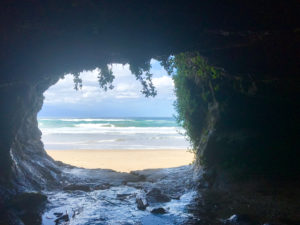
By Kelly Vinett
All morning, weather channels threaten a downpour on the Eastern Cape. Despite the grey skies highlighting the ocean’s azure, this site is nearly picture-perfect. Waves whip like a boomerang even at low tide. Post-card perfect in subtropical beauty, the South Coast has more to offer than meets the modern tourist’s eye.
We are on a hike, just outside the seaside town of Port Edward, on the South Coast of Kwa-Zulu Natal, where it meets the Eastern Cape.
Fellow student Francine Barchett who speaks to Mbotho as we hike tells me some of his story afterwards: He was an environmental manager for the filming who made sure that the forest was able to return to its original condition, she says.
“They removed lots of trees and plants before the filming and they returned them in the same exact condition through a GPS system—in the same exact place.”

Remnants of the movie set flank the inland path, looking more like ancient ruins than structures built for modern media. Tropical winds and rain have weathered them beyond repair.
They sit now among the remnants of a much older history.
“What I learned on the hike was about the [once] active volcanoes that were near South Africa… I didn’t know there would be lapilli that were on the beach itself,” Carrie Baker, another student studying abroad in Durban, said.
Lapilli are ancient, large spheres of volcanic magma that sit stagnant in the sand. Baker describes this phenomenon for geological amateurs.
“They look like [malt-ball candy] whoppers. If you take a whopper and make it sixty-four times the size, they’re these giant brown balls of magma.”
Mbotho tells us an anecdote from his childhood, about a fossil he and his friends serendipitously came upon at the shore.
“We were playing drums on this fossilized sea turtle. All of a sudden, we shattered the shell,” he said.
Mbotho points out in the thousands-of-years-old fossil the man-made bowling-ball sized fissure— a total accident, of course.
Also, Barchett reveals that the South Coast is home to groundbreaking anthropological discoveries.
“At this exact place at the South Coast where we were walking, that was where [some of] the first humans came from,” Barchett said.
The sky grows darker as we walk away from the shore. Mbotho points out a cow skeleton carcass, freshly killed, probably by a mamba snake, he says. Although a morbid moment, we are reminded of the inescapable circle of life.




